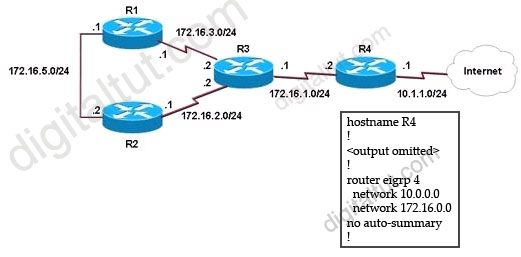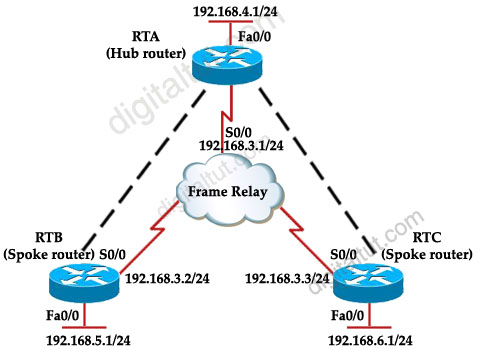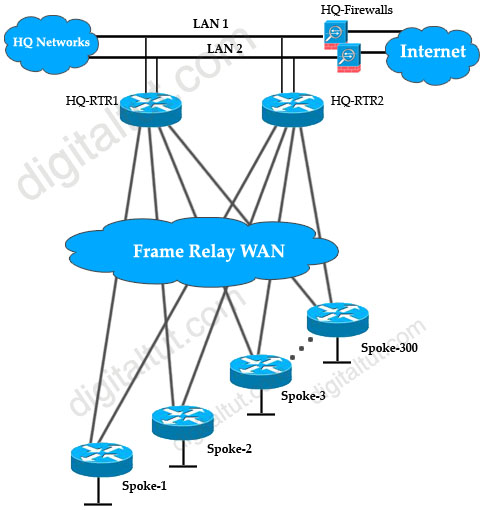EIGRP Questions 2
Here you will find answer to EIGRP Questions – Part 2
Question 1
Refer to the exhibit. EIGRP has been configured on all routers in the network. What additional configuration statement should be included on router R4 to advertise a default route to its neighbors?

A. R4(config)#ip default-network 10.0.0.0
B. R4(config)#ip route 0.0.0.0 0.0.0.0 10.1.1.1
C. R4(config)#ip route 10.0.0.0 255.0.0.0 10.1.1.1
D. R4(config-router)# default-information originate
Answer: A
Explanation
The “ip default-network ” command will direct other routers to send its unknown traffic to this network. Other router (R1,R2,R3) will indicate this network as the “Gateway of last resort”.
There is another way to route unknown traffic to 10.1.1.0/24 network: create a static route using “ip route 0.0.0.0 0.0.0.0 10.1.1.2” command then inject this route using the “network 0.0.0.0” command, or using “redistribute static” command.
Note: In EIGRP, default routes cannot be directly injected (as they can in OSPF with the default-information originate command. Also, EIGRP does not have the “default-information originate” command).
Question 2
Refer to the exhibit. Router RTA is the hub router for routers RTB and RTC. The Frame Relay network is configured with EIGRP, and the entire network is in autonomous system 1. However, router RTB and RTC are not receiving each other’s routes. What is the solution?

A. Configure the auto summary command under router eigrp 1 on router RTA.
B. Issue the no ip split horizon command on router RTA.
C. Configure subinterfaces on the spoke routers and assign different IP address subnets for each subinterface.
D. Check and change the access lists on router RTA.
E. Issue the no ip split horizon eigrp 1 command on router RTA.
Answer: E
Explanation
RTB and RTC cannot see each other because of the split horizon rule: “A router never sends information about a route back in same direction which is original information came”. To overcome this problem we can configure subinterfaces or disable split horizon with the command “no ip split horizon eigrp 1” on RTA.
Question 3
When troubleshooting an EIGRP connectivity problem, you notice that two connected EIGRP routers are not becoming EIGRP neighbors. A ping between the two routers was successful. What is the next thing that should be checked?
A. Verify that the EIGRP hello and hold timers match exactly.
B. Verify that EIGRP broadcast packets are not being dropped between the two routers with the show ip EIGRP peer command.
C. Verify that EIGRP broadcast packets are not being dropped between the two routers with the show ip EIGRP traffic command.
D. Verify that EIGRP is enabled for the appropriate networks on the local and neighboring router.
Answer: D
Question 4
Refer to the exhibit. You are the network administrator of the Route.com company. You have been tasked to implement a hub and spoke EIGRP topology over Frame Relay to provide connectivity between the networks at headquarters and all 300 spokes.
Before you begin the actual implementation, which three pieces of information are more important to know than the others? (Choose three)

A. the Committed Information Rate of all the Frame Relay PVCs
B. the Cisco IOS version running on all the routers
C. the router model number of all the spoke routers
D. the number of HQ networks connected behind the headquarter routers
E. the routing policy, such as whether or not the spokes can be used as backup transient point between the two headquarter routers
Answer: A B E
Question 5
Refer to the exhibit. The Route.com company is running EIGRP between all the routers. Currently, if one of the LAN links (LAN1 or LAN2) at the headquarters flaps (goes up and down), the HQ-RTR1 and HQ-RTR2 routers will experience high CPU usage and have a long EIGRP convergence time. As the new network administrator, you are asked to investigate this situation and determine if there is a quick way to resolve this issue.
Which is the most important thing that you can quickly verify first to resolve this issue?

A. Verify that the bandwidth setting on all WAN links is correct.
B. Verify that the HQ-RTR1 and HQ-RTR2 routers are configured to send only a default route to all the spoke routers.
C. Verify that the HQ-RTR1 and HQ-RTR2 routers are configured for EIGRP Nonstop Forwarding.
D. Verify that all the spoke routers are configured for autosummarization.
E. Verify that all the spoke routers are configured as EIGRP stub.
Answer: E
Question 6
Refer to the exhibit. When you examine the routing table of R1 and R4, you are not able to see the R1 Ethernet subnet on the R4 routing table. You are also not able to see the R4 Ethernet subnet on the R1 routing table.
Which configuration change should be made to resolve this issue? Select the routers where the configuration change will be required, and select the required EIGRP configuration command(s). (Choose two)

A. R1 and R4
B. R2 and R3
C. ip summary-address eigrp 1 10.1.1.0 255.255.255.0 and ip summary-address eigrp 1
D. variance 2
E. eigrp stub connected
F. no auto-summary
Answer: B F
Question 7
Refer to the exhibit. The actual speed of the serial links between R2 and R3 are 256 kb/s and 512 kb/s respectively. When configuring EIGRP on routers R2 and R3, the network administrator configured the bandwidth of both serial interfaces to 512 kb/s. What will be the effect?

A. EIGRP will overutilize the 512 kb/s link.
B. The interface “delay” value used in the EIGRP metric calculation will be inaccurate on the 256 kb/s serial interface.
C. The amount of bandwidth used for EIGRP routing protocol traffic on the 256 kb/s link can become excessive.
D. EIGRP can load balance between the two serial links only if the variance is set to 2 or higher.
E. Unequal cost load balancing will be disabled.
Answer: C


